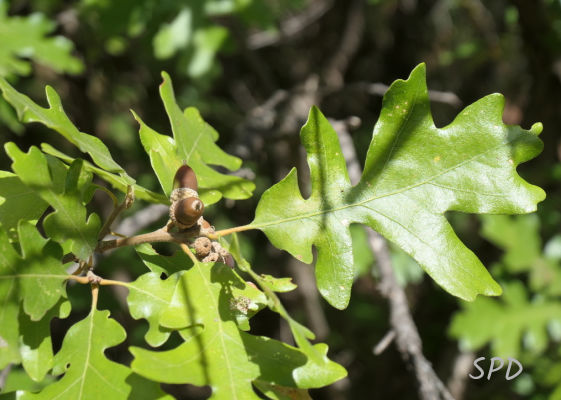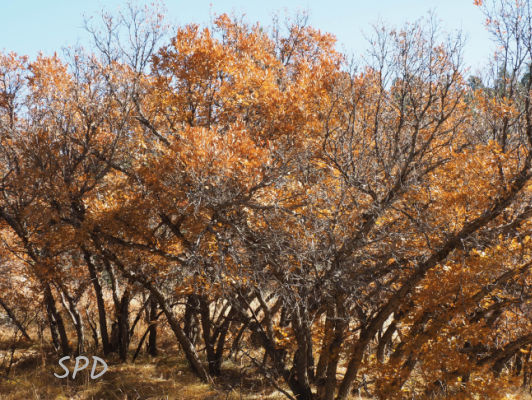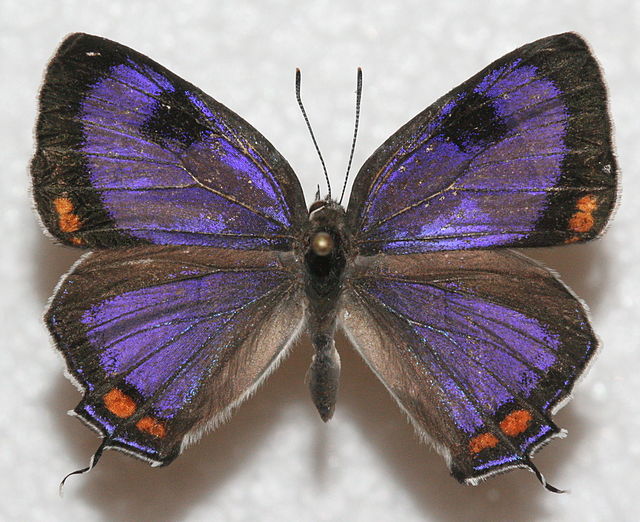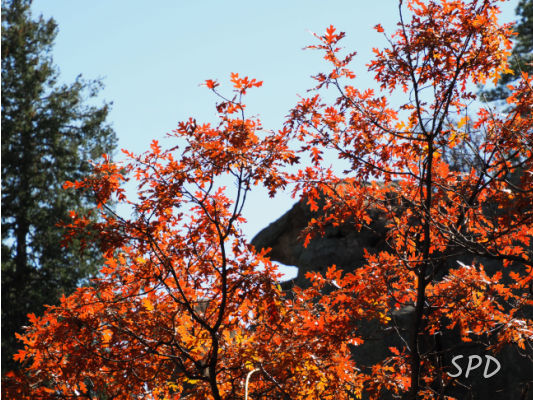The leaves of Gambel oak are pinnately lobed at least halfway to the midrib, and are rounded. The lower leaf surface has stellate hairs, with five or fewer arms. Fall colors are vibrant!
It’s no gamble at all with the Gambel oak, Quercus gambelii, which is Colorado’s most abundant and widespread oak, and an important contributor to our state’s biodiversity. That’s Gambel, of course, not gamble; the tree was named in honor of William Gambel, an explorer and naturalist active in the west in the early 1800’s. Mr. Gambel must have been a brilliant soul, because not only is our native oak named for him but so are several birds, including the Mountain chickadee, Poecile gambeli, in spite of the fact that he was on this earth for only 26 years. Now that the tree’s name is explained, let’s explore the role of Gambel oak in the ecosystem, and ways it can be incorporated in landscapes.
First a short sideline about Oak Identity Crisis. Quercus gambelii is not our only native oak, there are two others present, or perhaps present, in Colorado, Quercus turbinella, Sonoran scrub oak and Quercus grisea, gray oak. However, as Ackerfield explains in the Flora of Colorado, each of these three species hybridize freely where their ranges overlap, so sometimes it’s just a bit hard to make a definitive ID. Q. grisea occurs only in one tiny southeast corner of the state, but Ackerfield posits that it probably does not exist in pure form there because it is usually found growing with other oaks of hybrid origin. Q. turbinella, smaller than Gambel, and having sharp points on its leaves, occurs in only eight counties, and in elevations under 7,000 feet, while Q. gambelii can be found all the way up to 10,500 feet. In everyday rambles odds are that Quercus gambelii is the oak you are most likely to see.
.
A grove of Gambel oak trees in fall at Castlewood Canyon Park near Franktown.
A single-stemmed Gambel oak, also at Castlewood, this is possibly a genetic trait.
Some Gambels are found in a single truck form, but most are multi-stemmed. They tend to form dense thickets on dry canyon slopes, but in meadows may be spaced more generously apart. A tough survivor, the Gambel oak is small but mighty, able to tolerate rocky soil, high winds, heavy snow, fire, and drought. It survives drought thanks to its deep roots and xeromorphic leaves which have the ability to store water.
The underground system of Gambel oak consists of a lignotuber with deep-feeding roots. Lignotubers possess many scattered adventitious buds. Clones are interconnected with rhizomes that intertwined with lignotubers.
The upshot of all that is the Gambel tends to sprout new trunks and form colonies with ease. If you have forgotten what a lignotuber is, check out the Cal Flora’s Botanical terms site. Those readily sprouting roots allow Gambel oak to regenerate quickly after a fire, but they’re also fire prone, so not a good plant to have close to your house.
Small round acorns of Gambel oak with caps that cover the whole top.
Dense thickets of Gamble oak stands are great providers of food and shelter for many forms of Colorado’s wildlife. The prolific crops of acorns are food for chipmunks, squirrels, deer, turkeys, and bears. Birds make use not only of acorns and buds, but also of the insects associated with tree. The Rocky Mountain Research published a comprehensive study about value of Gambel oak to birds. Copy and paste this URL into your browser to download the PDF
Bird Communites of Gambel Oak :
https://www.fs.usda.gov/research/treesearch/29148
Colorado state butterfly, the Colorado hairstreak. This butterfly spends its entire life within thickets of Gambel oak. The larvae can eat only Gambel oak leaves.
Photo courtesy of: Megan McCarty, CC BY-SA 3.0 <https://creativecommons.org/licenses/by-sa/3.0>, via Wikimedia Commons
A beautiful citizen of the Gambel oak thicket is our Colorado Hairstreak butterfly, Hypaurotis crysalus, which spends its entire life cycle within the thicket. Through the efforts of a fourth grade class in Aurora, this butterfly was designated as the state butterfly. The larvae (caterpillar babies) of the Colorado hairstreak can eat only the leaves of Quercus gambelii, just as the monarch butterfly larvae can eat only milkweed leaves. It takes a lot of adaptation to overcome the chemical defenses of any plant! Adult hairstreaks feed on tree sap and sweet liquids exuding from oak insect galls. Look for this butterfly in Gamble oak groves in the foothills late in the afternoon during July and August. If you want to know more about Colorado’s butterflies, our bookstore stocks Janet Chu and Stephen Jones’s Butterflies of Colorado Front Range.
What about Gambel oak in the landscape? In his recent book devoted solely to oaks, The Nature of Oak Trees: The Rich Ecology of Our Most Essential Native Trees, Doug Tallamy states that he would like to see the Gambel being used more widely in western landscapes. I talked with Mike Kintgen, Curator of Alpine Collections and Horticulture Specialist at the Denver Botanic Gardens, about his thoughts on the subject, and whether the spreading nature of the tree could pose problems, but Mike agreed that he also would like to see wider use of Gambel oak in landscapes and placement was key. He said:
“Certain clones of Gambel oak are more colony forming than others. Some can live as single stemmed or a few individual stems for many years if not the entire life span of the plant which is hundreds of years in the right setting. The colony forming growth habit can be problematic when used for a street tree ( new stems are continually trying to come up each year). This can also be a problem if people want a “very neat and clean” looking small tree or large shrub in the landscape. I love Gambel oaks in informal screening or more naturalist gardens such as xeriscapes, native plant garden, along the edges of meadow gardens, and as backdrop to more traditional plantings if one has the room. I love them as informal groves as well in public landscapes such as parks or around office buildings.”
When asked if homeowners usually wanted a single trunked oak for their landscapes, Mike replied “Not necessarily,” and said that his own preference was for the multi-stemmed form. He also noted that stress such as damage to the trunk (from leaf blowers or grass trimmers for instance) can stimulate suckering in a Gambel oak.
When floral displays of color are fading from our lives in the fall, the Gambel oak really stands out with its magnificent array of leaves in red, orange, yellow and gold. Fall color, drought tolerance, and important associations within our Colorado ecoysytems certainly make this a tree for all reasons!
Sue Dingwell
Media Committee
Colorado Native Plant Society
References online:
Simonin, Kevin A. 2000. Quercus gambelii. In: Fire Effects Information System, [Online]. U.S. Department of Agriculture, Forest Service, Rocky Mountain Research Station, Fire Sciences Laboratory (Producer).
U.S. Department of Agriculture, Forest Service, Rocky Mountain Research Station, General Technical Report GRMS-STR-48, March, 2000
Southwest Colorado Wildflowers:
https://www.swcoloradowildflowers.com/index.htm
The Butterfly Pavillion
https://butterflies.org/
University of Utah Tree Tour
https://facilities.utah.edu/tree-tour/tree-display.php?tree_name=gambel-oak
The Backyard Gardener
https://www.youtube.com/@BACKYARDGARDENER
Santa Fe Botanical Garden
https://santafebotanicalgarden.org/october-2015/
Book references:
Flora of Colorado
Jennifer Ackerfield
Britt Press, 2015
Butterflies of the Colorado Front Range
A Photographic Guide to 200 Species
Janet R. Chu & Stephen R. Jones
Boulder County Nature Association, 2020
Gambel oak in fall at Castlewood Canyon Park.






